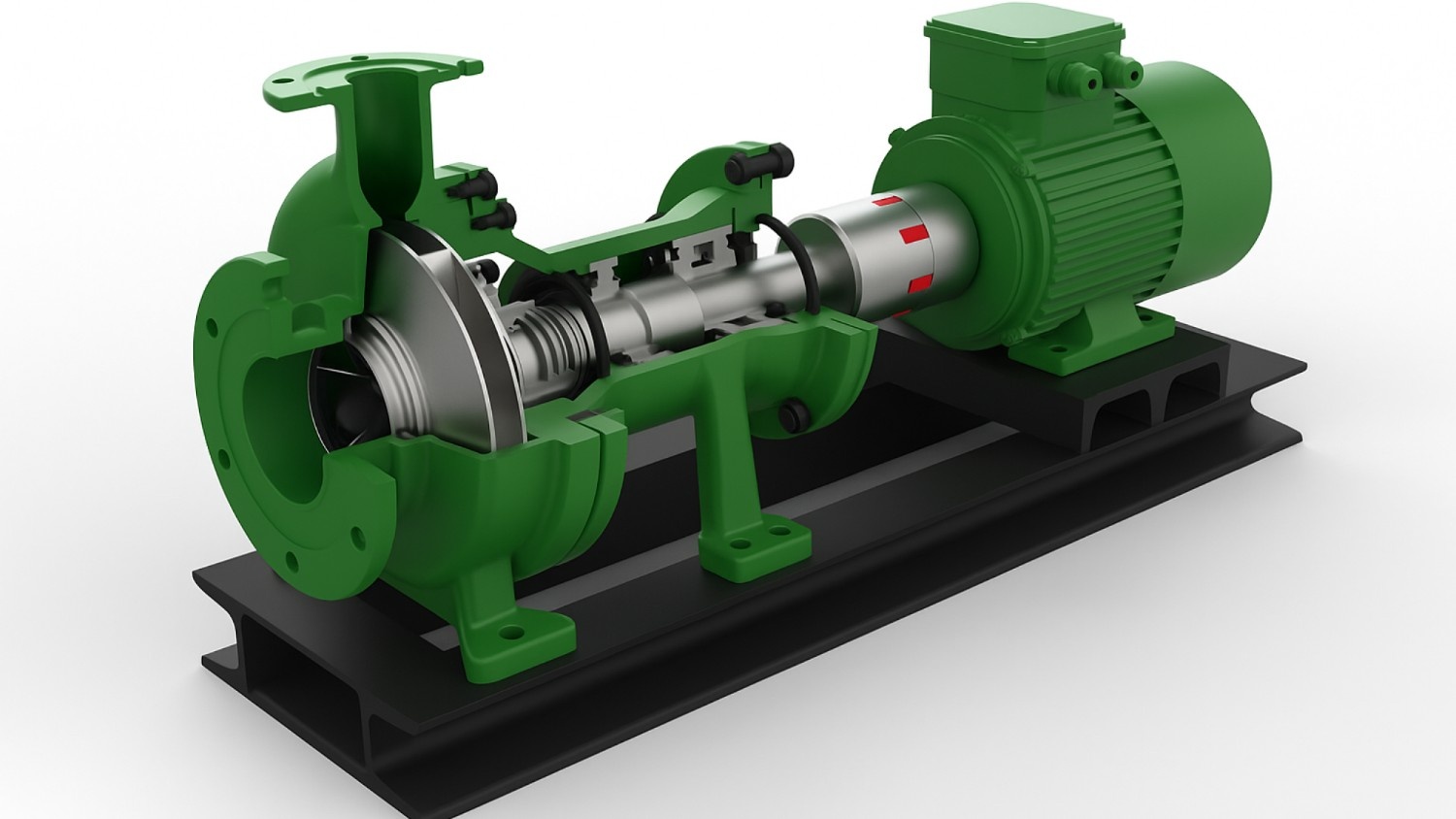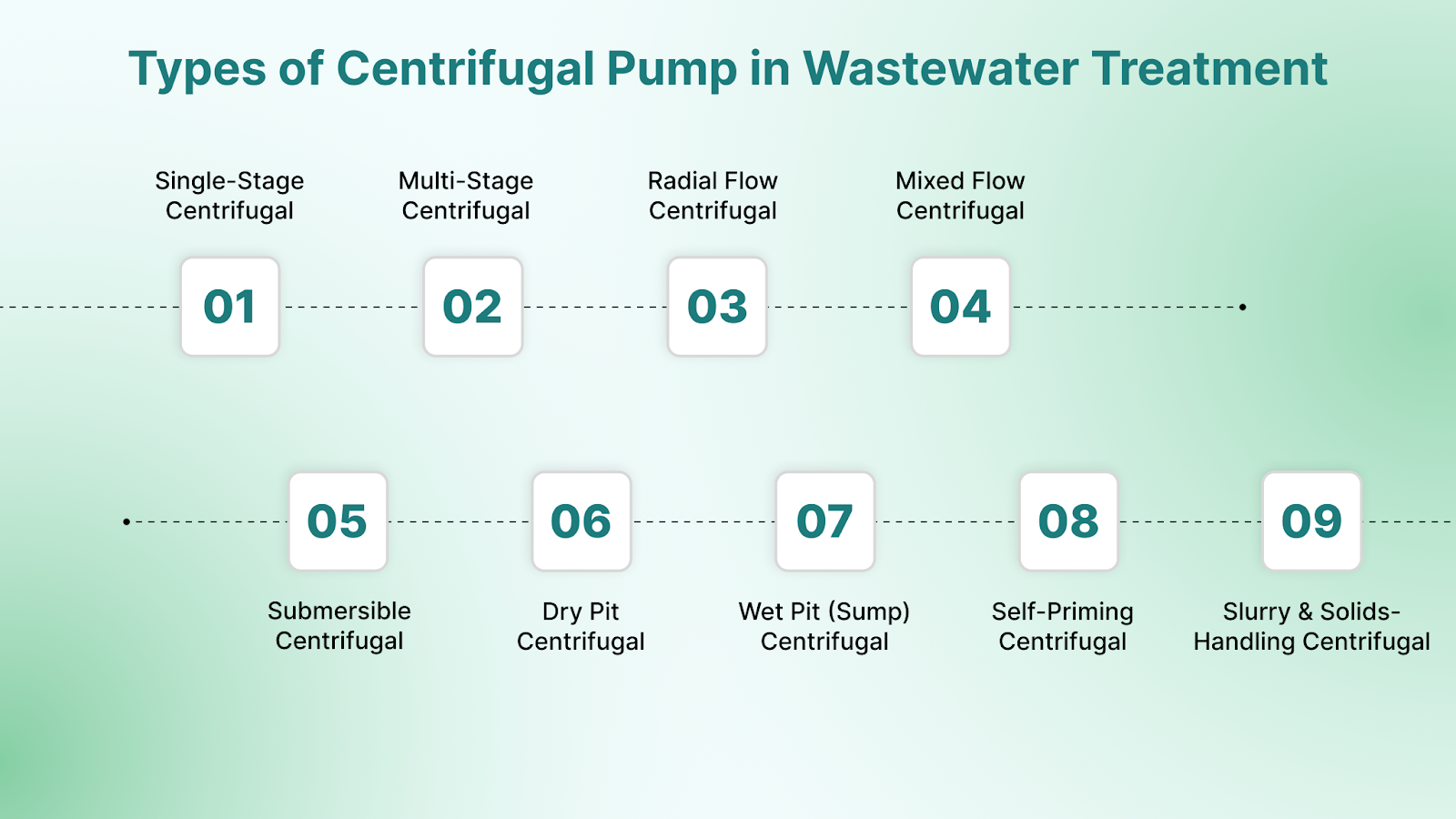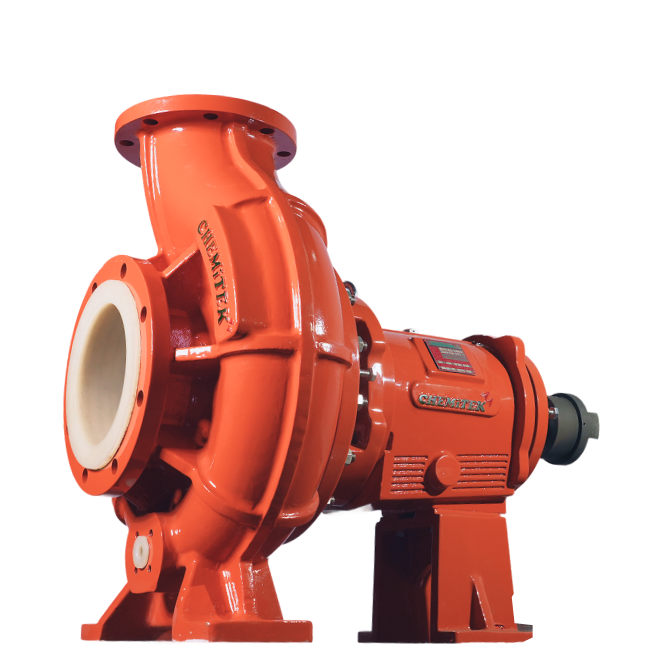Wastewater treatment plants handle highly variable fluids, ranging from abrasive sludges to chemical-laden liquids, making pump selection a critical engineering decision. Centrifugal pumps play a vital role by providing reliable fluid transfer, lower maintenance, and energy efficiency.
However, not all centrifugal pumps perform equally. Choosing the wrong type can result in cavitation, unplanned downtime, or seal failure. Selecting the right pump ensures operational stability, improved throughput, and lower lifecycle costs.
This guide outlines the types of centrifugal pump in wastewater treatment and how each design suits specific plant conditions and process requirements.
Key Takeaways:
- Centrifugal pump in wastewater treatment are essential for fluid transfer, sludge handling, and chemical dosing.
- Pump selection depends on fluid composition, flow rate, head requirements, temperature, and solids content.
- Types of centrifugal pump in wastewater treatment include single-stage, multi-stage, radial, axial, mixed flow, submersible, dry pit, wet pit, self-priming, and solids-handling pumps.
- Every centrifugal pump variant is designed for a specific function and comes with its own benefits and considerations around maintenance, cost, and performance.
To understand where each pump fits, it helps to first know how centrifugal pumps work in wastewater environments.
What Is a Centrifugal Pump in Wastewater Treatment?

A centrifugal pump in wastewater treatment uses rotational energy from an impeller to move fluids across key stages such as screening, sedimentation, aeration, and sludge handling.
Unlike positive displacement pumps that move fixed volumes, centrifugal pumps generate flow by creating velocity. They efficiently handle large volumes of low-viscosity fluids like raw sewage or treated effluent. Their simple design and low maintenance make them ideal for continuous-duty use.
With a clear view of how centrifugal pumps function, it’s important to see where they are applied within a typical wastewater treatment system.
Key Role of Centrifugal Pump in Wastewater Applications
Centrifugal pumps are central to wastewater operations, managing everything from sewage inflow to sludge recirculation. Used across municipal, industrial, and recycling systems, they efficiently handle large volumes, variable fluid consistencies, and corrosive content under continuous duty cycles.
Here’s where and how centrifugal pumps are typically used in waste water treatment:
- Influent Transfer: Pumps transfer raw sewage from the collection system into the preliminary treatment area.
- Sludge Handling: Specialized slurry or recessed impeller pumps manage thickened sludge without clogging.
- Aeration Support: Mixed or axial flow pumps circulate water in aeration basins for efficient oxygenation.
- Effluent Discharge: Treated water is moved using corrosion-resistant pumps designed for continuous operation.
- Chemical Dosing and Neutralisation: Metering centrifugal pumps help introduce treatment chemicals at precise flow rates.
- Lift Stations: Submersible and self-priming pumps are crucial in areas with uneven terrain or underground collection systems.
Each pump type is engineered to meet the flow, pressure, and contamination level of the specific treatment stage.
9 Types of Centrifugal Pump in Wastewater Treatment

Reliability and performance are crucial in wastewater treatment, where pump failure can disrupt entire processes. Different treatment stages require pumps that can manage specific flow conditions, contaminants, and pressures without frequent maintenance.
Below are the key types of centrifugal pumps used in wastewater treatment, each designed to meet distinct operational needs:
1. Single-Stage Centrifugal Pumps
Single-stage centrifugal pumps use a single impeller to move fluid efficiently. These pumps are known for their simple design, quick installation, and low maintenance requirements. They are widely used for general wastewater transfer where moderate flow and pressure are sufficient.
Applications:
- Recirculation of Return Activated Sludge (RAS) in extended aeration and conventional activated sludge processes
- Transfer of disinfected or chlorinated final-stage effluent to distribution or holding tanks
- Continuous effluent circulation in biological treatment zones such as oxidation ditches or MBBR tanks
Specifications:
- Materials: Cast Iron, SS316, FRP-lined variants for corrosive media
- Mounting Options: Close-coupled, Long-coupled, or Vertical Inline
Example:
Deployed in aeration basins to recirculate mixed liquor suspended solids (MLSS) back to secondary clarifiers in nutrient removal systems.
Why It Matters:
- Designed for non-stop operation in harsh, solid-laden wastewater conditions, ensuring stable biological process performance
- Simplifies plant layout through versatile mounting and piping configurations, reducing installation time and footprint
- Low vibration and wear rate, especially when equipped with dynamically balanced impellers and hardened shafts, leading to longer service intervals and reduced lifecycle cost
2. Multi-Stage Centrifugal Pumps
Multi-stage centrifugal pumps use two or more impellers in series to progressively increase pressure with each stage. These pumps are ideal for high-head applications in wastewater treatment where fluid needs to be moved across longer distances or to elevated points within the facility.
Applications:
- Transfer of treated effluent from underground collection tanks to elevated storage reservoirs
- High-pressure backwash in tertiary filtration systems
- Long-distance transfer of reclaimed water for reuse or irrigation purposes
Specifications:
- Materials: SS316, Cast Iron with epoxy coating, Duplex Steel for high-pressure and corrosive environments
- Mounting Options: Horizontal or Vertical multistage configurations
Example: Used to transport disinfected water from effluent polishing units to remote reuse zones or rooftop storage tanks in decentralized wastewater treatment systems.
Why It Matters:
- Enables high-pressure delivery without large pumps, making it suitable for compact installations
- Improves energy efficiency by matching stage configuration to required head and flow
- Supports water reuse systems that demand consistent pressure and long-term reliability
3. Radial Flow Centrifugal Pumps
Radial flow centrifugal pumps direct liquid flow perpendicular to the pump shaft, creating high pressure with moderate flow. These pumps are ideal for applications requiring high head and are commonly used in secondary treatment and filtration zones within wastewater treatment plants.
Applications:
- Sludge return pumping in high-head clarifiers
- Transfer of treated effluent to elevated filtration or disinfection stages
- Backwashing operations in tertiary treatment systems
Specifications:
- Materials: Cast Iron, Duplex SS, Epoxy-coated internals for corrosive resistance
- Mounting Options: Horizontal split-case or vertical turbine configurations
Example: Installed in multistage filtration systems to move clarified effluent to pressure sand filters or UV disinfection units located on elevated platforms.
Why It Matters:
- Generates high pressure for overcoming elevation or resistance in complex treatment networks
- Compact footprint and sealed design help reduce leakage risks in high-pressure zones
- Ideal for regulated zones where pressure consistency is essential for downstream process efficiency
4. Mixed Flow Centrifugal Pumps
Mixed flow centrifugal pumps combine radial and axial flow characteristics to deliver moderate head and high flow rates. These pumps are particularly suited for large-volume transfer applications in wastewater treatment where a balance between flow and pressure is essential.
Applications:
- Effluent transfer from equalization tanks to aeration basins
- Pumping clarified water from secondary clarifiers to tertiary treatment zones
- Handling large volumes of partially treated water in stormwater bypass systems
Specifications:
- Materials: Cast Iron, SS304/316, Coated Carbon Steel for aggressive media
- Mounting Options: Vertical column type or inclined configurations
Example: Used in equalization tanks to transfer partially treated sewage to aeration tanks during peak inflow periods in municipal STPs.
Why It Matters:
- Delivers high flow capacity with energy efficiency in medium-head applications
- Prevents hydraulic surges in large-volume zones by maintaining consistent flow
- Robust construction handles fluctuating flow conditions and suspended solids reliably
5. Submersible Centrifugal Pumps
Submersible centrifugal pumps are installed directly inside the fluid they are meant to handle. These sealed pumps are ideal for submerged conditions, offering quiet operation and eliminating the need for priming. They are widely used in lift stations, sumps, and sludge-handling zones in wastewater treatment.
Applications:
- Pumping raw sewage from collection pits to primary treatment units
- Sludge transfer from secondary clarifiers to digesters or dewatering systems
- Draining stormwater and overflow tanks during peak inflow conditions
Specifications:
- Materials: Cast Iron, SS304/316, Chrome-alloy-coated wear parts
- Mounting Options: Guide-rail-mounted, Portable, or Fixed Wet-well Installation
Example: Installed in underground lift stations to transfer screened wastewater to equalization tanks in decentralized STPs.
Why It Matters:
- Enables efficient pumping from deep or flooded locations without external priming or suction issues
- Minimizes odor and noise concerns with fully submerged, sealed operation
- Reduces footprint by eliminating the need for separate dry well or suction piping infrastructure
6. Dry Pit Centrifugal Pumps
Dry pit centrifugal pumps are installed outside the wastewater sump or tank in a dry, accessible location. They are connected to the wet well via suction piping and are ideal for applications where ease of access, regular maintenance, and flood protection are priorities.
Applications:
- Raw sewage pumping from deep wells in municipal sewage pumping stations
- Transfer of primary or secondary sludge from clarifiers to digesters
- Effluent lift operations in STPs with deep collection basins
Specifications:
- Materials: Cast Iron, SS316, epoxy-coated internal components for corrosion resistance
- Mounting Options: Horizontal split-case, End-suction frame-mounted
Example: Used in large-scale municipal wastewater plants to lift raw sewage from underground sumps to headworks, minimizing flood risk in low-lying plant zones.
Why It Matters:
- Dry motor location allows safe, quick access for inspection and servicing without requiring sump dewatering
- Reduces the risk of motor damage due to submersion or leakage, making it ideal for flood-prone or underground facilities.
- Efficient for high-volume pumping and compatible with VFDs for controlled flow based on real-time process demand
7. Wet Pit (Sump) Centrifugal Pumps
Wet pit centrifugal pumps, also known as vertical sump pumps, are installed directly over the wet well with the pump bowl submerged and the motor mounted above. These pumps are specifically designed for handling raw or partially treated wastewater with suspended solids in open or semi-open sump applications.
Applications:
- Pumping raw influent from bar screens or coarse screening chambers
- Sludge withdrawal from primary or secondary clarifiers
- Stormwater and overflow control in municipal and industrial wet wells
Specifications:
- Materials: Cast Iron, Bronze-fitted, or SS304/316 for corrosive and abrasive media
- Mounting Options: Vertical column-mounted with intermediate shaft bearings
Example: Used in large municipal wet wells to lift screened sewage to the inlet of a grit chamber or primary clarifier for further treatment.
Why It Matters:
- Motor stays dry and accessible, allowing easier inspection and service without dismantling the pump
- Handles variable flow and solids without clogging, ideal for fluctuating influent conditions
- Vertical configuration minimizes plant footprint and simplifies sump tank integration
8. Self-Priming Centrifugal Pumps
Self-priming centrifugal pumps are designed to evacuate air from the suction line and prime themselves automatically. These pumps are ideal for installations where suction lift conditions exist, and manual priming is impractical or unsafe. They are commonly used in wastewater systems where intermittent flows or remote sump locations are involved.
Applications:
- Transfer of wastewater from collection pits where gravity feed is not feasible
- Sludge handling in remote clarifiers or grit removal systems
- Intermittent pumping from equalization basins or stormwater holding tanks
Specifications:
- Materials: Cast Iron, Bronze-fitted, or corrosion-resistant coated variants
- Mounting Options: Frame-mounted or close-coupled with back-pullout design
Example: Installed outside a stormwater wet well to lift surface runoff and grit-laden water during monsoon events without manual priming intervention.
Why It Matters:
- Enables above-ground installation, reducing confined space hazards and simplifying maintenance
- Ideal for irregular or emergency flows, ensuring reliable operation without frequent manual oversight
- Integrated air-handling capability prevents air-locks and ensures quick restart after dry runs or shutdowns
9. Slurry and Solids-Handling Centrifugal Pumps
Slurry and solids-handling centrifugal pumps are engineered to handle abrasive, viscous, and high-solids-content fluids typically found in wastewater sludge streams. These pumps feature large, open impellers and wear-resistant materials that enable reliable performance under tough operating conditions.
Applications:
- Pumping thickened sludge from primary or secondary clarifiers to dewatering units
- Handling grit and screenings in headworks and pre-treatment zones
- Transporting slurry in sludge digesters or equalization tanks
Specifications:
- Materials: High-chrome alloys, Hardened SS, Rubber-lined or ceramic-coated variants
- Mounting Options: Horizontal end-suction, Submersible, or Vertical cantilever designs
Example: Installed in sludge handling units to move high-viscosity, grit-laden sludge from thickener tanks to centrifuges or belt filter presses.
Why It Matters:
- Tolerates large solids and high abrasiveness without clogging or rapid wear
- Extends pump life in harsh sludge environments, reducing downtime and replacement frequency
- Maintains consistent flow even with variable sludge concentration, ensuring uninterrupted dewatering and disposal operations
Effective pump selection starts with understanding your wastewater system's fluid characteristics, process stages, high-grade materials and operating conditions.
How To Select the Centrifugal Pump for Wastewater Treatment?
The efficiency of your wastewater treatment relies heavily on choosing the right centrifugal pump. It must handle solids, corrosive fluids, and sludge effectively under real plant conditions. Poor selection can cause clogging, cavitation, and early failure.
Here’s a practical breakdown to help you identify the most effective centrifugal pump in wastewater treatment for your system.
Define the Nature of Wastewater Being Handled
The physical and chemical properties of wastewater directly influence the type of centrifugal pump required. Factors like solids content, corrosiveness, and viscosity determine which pump design works best under actual plant conditions.
Match Pump Type to System Layout
- Below-ground sumps or basins: Go for submersible centrifugal pumps or vertical centrifugal pumps
- Suction lift installations: Use a centrifugal self-priming pump or fluoroplastic self-priming centrifugal pump
- Large tank circulation systems: Choose mixed flow or axial flow pumps suited for high-flow, low-head conditions
Evaluate Head, Flow Rate & Energy Demand
- High-pressure transfer (e.g., filtration or spray systems): Use a multi-stage or horizontal high-pressure centrifugal pump
- Variable duty cycles: Consider single-stage ANSI centrifugal pumps with VFD-compatible motors
- For low operational costs: Choose energy-efficient chemical pumps with hydraulically optimized internals
Handle Solids and Abrasive Content with the Right Design
- Heavy sludge, slurry, and fibrous media: Use industrial slurry pumps with wear-resistant wetted parts
- Grit and small particles: Choose open or vortex impeller pumps to reduce clogging
- Settled solids in sumps: Opt for wet pit centrifugal pumps with optional agitation for solid suspension
Consider Installation & Maintenance Factors
- Tight or hard-to-access locations: Use inline centrifugal pumps or compact submersible designs
- Maintenance-intensive zones: Select cartridge-style pumps or self-priming process pumps
- Hazardous areas: Confirm compatibility with toxic fluid pumps or ATEX-rated chemical process pumps
Choose the Right Construction Materials
The pump’s construction material should align with the fluid’s chemistry, temperature, and system demands to ensure long-term reliability.
Go for Efficiency and Lifecycle Cost Optimization
- Best horizontal centrifugal pump designs combine low power consumption with smooth hydraulic performance
- Sealless centrifugal pump and magnetic drive process pumps eliminate leakage risk and reduce maintenance
- Work with a custom process pump manufacturer for unique applications requiring personalized solutions
Looking for the right centrifugal pump for wastewater treatment? Match pump type to your fluid and site needs. Explore here.
Chemitek: Reliable Centrifugal Pumps for Wastewater Use
Since 2009, Chemitek Process Equipment Pvt. Ltd. has supplied high-performance centrifugal pumps for demanding wastewater applications. Our range includes submersible, slurry-handling, self-priming, and horizontal centrifugal pumps, ANSI/ASME B73.1, all built to handle corrosive, abrasive, and solids-laden fluids with precision.
Designed for continuous duty, Chemitek pumps feature wear-resistant internals and low-clogging impellers. With material choices like SS316, SS316L, Hastelloy, Alloy 20, PP, and PVDF, they ensure reliable operation in harsh and high-temperature environments.
Engineered with advanced CAD/CAM systems and strict quality controls, our pumps deliver safe, efficient, and long-lasting performance.
Reach out today to discuss your flow rate, solids handling, and corrosion resistance needs so you can move wastewater smarter and more reliably.
FAQs
1. Which centrifugal pump types are most used in wastewater treatment?
Common types include single-stage pumps for general transfer, multi-stage pumps for high-pressure applications, submersible pumps for sump and pit use, and slurry-handling pumps for thick sludge. Self-priming, axial flow, and mixed flow pumps are also widely used, depending on plant layout and fluid properties.
2. How does a submersible centrifugal pump differ from a dry pit pump?
Submersible pumps run while fully submerged and have sealed motors, making them suitable for sumps or flood-prone areas. Dry pit pumps stay dry and are placed outside the wet well. They offer easier access for maintenance but need priming and protection from external damage.
3. When should I use a self-priming centrifugal pump in wastewater systems?
Use a self-priming pump when the fluid source is below the pump’s level. It builds suction on its own, making it ideal for above-ground setups, lift stations, or systems that start and stop frequently without needing manual priming.
4. Why are slurry-handling pumps important in wastewater treatment?
Slurry pumps are built to manage thick, abrasive fluids like sludge and grit. Their open or recessed impellers and wear-resistant parts prevent clogging and erosion, making them reliable for heavy sludge transfer and long operational life.
5. How do axial and mixed flow pumps fit into wastewater applications?
Axial flow pumps move large volumes at low pressure, perfect for recirculation tanks or drainage. Mixed flow pumps combine radial and axial motion, giving moderate flow and head. Both types work well in large treatment plants with high water movement.

Latest posts
Ready to Upgrade Your Process Operations?
